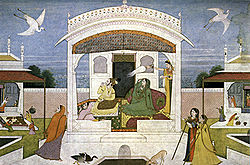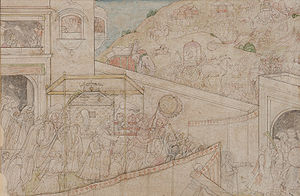- Nishadha Kingdom
-
Nishadha was the kingdom of the celebrated king Nala, who loved and married Damayanti the princess of Vidarbha Kingdom. This kingdom is identified with current day Gwalior district of Madhya Pradesh. Nishadha was connected to Dasarna and Kosala as well as with Vidarbha through trade routes.
References in Mahabharata
Connection with the Kuru Dynasty of kings
See Also: Kuru Kingdom
- Mahabharata, Book 1, Chapter 94
Samvarana begat upon his wife, Tapati, the daughter of Surya, a son named Kuru. He was installed on the throne by his people. It is after his name that the field called Kurujangala has become so famous in the world. Devoted to asceticism, he made that field (Kurukshetra) sacred by practising asceticism there. Kuru’s wife, Vahini, brought forth five sons, viz., Avikshit, Bhavishyanta, Chaitraratha, Muni and the celebrated Janamejaya (Janamejaya the 2nd). And Avikshit begat Parikshit (Parikshit the 1st) the powerful, Savalaswa, Adhiraja (Dantavaktra was a king of the Adhirajas), Viraja, Salmali of great physical strength, Uchaihsravas, Bhangakara and Jitari the eighth. In the race of these were born, seven mighty car-warriors with Janamejaya (Janamejaya the 3rd) at their head. And unto Parikshit (Parikshit the 1st) were born Kakshasena and Ugrasena, and Chitrasena and Indrasena and Sushena and Bhimasena. And the sons of Janamejaya (Janamejaya the 3rd) were Dhritarashtra (Dhritarashtra the 1st)who was the eldest, and Pandu (Pandu the 1st) and Valhika (Vahlika the 1st), and Nishadha and Jamvunada, and then Kundodara and Padati and then Vasati the eighth.
Among them Dhritarashtra (Dhritarashtra the 1st) became king. And Dhritarashtra (Dhritarashtra the 1st) had eight sons, viz., Kundika, Hasti, Vitarka, Kratha the fifth, Havihsravas, Indrabha, and Bhumanyu , and Dhritarashtra (Dhritarashtra the 1st) had many grandsons, of whom three only were famous. They were, O king, Pratipa, Dharmanetra, Sunetra. Among these three, Pratipa became unrivalled on earth. And, Pratipa begat three sons, viz., Devapi, Santanu, and Valhika (Vahlika the 2nd). The eldest Devapi adopted the ascetism. And the kingdom was obtained by Santanu and Valhika.
The history of King Nala of Nishadha
- Mahabharata, Book 3, Chapter 52
There was a celebrated king among the Nishadhas, named Virasena. He had a son named Nala, versed in the knowledge of virtue and wealth. It hath been heard by us that, that king was deceitfully defeated by Pushkara, and afflicted with calamity, he dwelt in the woods with his spouse Damayanti.
Nala to Damayanti, on the roads running through Nishadha Kingdom
- Mahabharata, Book 3, Chapter 61
These many roads lead to the southern country, passing by (the city of) Avanti and the Rikshavat mountains. This is that mighty mountain called Vindhya; yon, the river Payasvini running seawards, and yonder are the asylums of the ascetics, furnished with various fruit and roots. This road leadeth to the country of the Vidarbhas—and that, to the country of the Kosalas. Beyond these roads to the south is the southern country.’ Addressing Bhima’s daughter, he distressed king Nala spake those words unto Damayanti over and over again.
Giriprastha, a place in Nishadha
- Mahabharata, Book 3, Chapter 313
Indra for the purpose of overcoming his foes, dwelt in disguise in the asylum of Giriprastha, in Nishadha and thus attained his end.
A Mountain Range named Nishadha
- Mahabharata, Book 6, Chapter 6
Stretching from east to west, are these six mountains that extend from the eastern to the western ocean. They are Himavat, Hemakuta, that best of mountains called Nishadha, Nila abounding with stones of lapis lazuli, Sweta white as the moon, and the mountains called Sringavat composed of all kinds of metals.
- Mahabharata, Book 6, Chapter 7
On the south of Nila and the north of Nishadha, there is a huge Jamvu tree that is eternal.
- Mahabharata, Book 6, Chapter 8
On the south of Sweta and the north of Nishadha, is the Varsha (Region or a sub-continent), called Romanaka. The men that are born there are all of white complexion, of good parentage, and handsome features. And the men born there are also all without enemies. On the south of Nishadha is the Varsha called Hiranmaya where is the river called Hiranwati. There liveth the great Garuda. And the people there are all followers of the Yakshas, wealthy, and of handsome features. The men there are endued with great strength and have cheerful hearts.
Nishadha, in the list of Kingdoms in Bharata Varsha (Ancient India)
- Mahabharata, Book 6, Chapter 9
..........the Pundras, the Bhargas, the Kiratas, the Sudeshnas, and the Yamunas, the Sakas, the Nishadhas, the Anartas, the Nairitas, the Durgalas, the Pratimasyas, the Kuntalas, and the Kusalas; the Tiragrahas, the Ijakas, the Kanyakagunas, the Tilabharas, the Samiras, the Madhumattas,..........
Nishadhas in Kurukshetra War
- Mahabharata, Book 7, Chapter 20
Drona sets the troops in Garuda Military Configuration
In the tail of the array stood Vikartana’s son Karna, with his sons, kinsmen and friends, and surrounded by a large force raised from diverse realms, Jayadratha, and Bhimaratha, and Sampati, and the Jays, and the Bhojas, and Bhuminjaya, and Vrisha, and Kratha, and the mighty ruler of the Nishadhas, all accomplished in battle, surrounded by a large host, in the heart of that array.
Karna's Military Campaign
- Mahabharata, Book 8, Chapter 8
He had subjugated many invincible and mighty foes—the Gandharas, the Madrakas, the Matsyas, the Trigartas, the Tanganas, the Khasas, the Pancalas, the Videhas, the Kulindas, the Kasi-kosalas, the Suhmas, the Angas, the Nishadhas, the Pundras, the Kichakas, the Vatsas, the Kalingas, the Taralas, the Asmakas, and the Rishikas.
See also
Kingdoms of Ancient India
References
- Mahabharata of Krishna Dwaipayana Vyasa, translated to English by Kisari Mohan Ganguli
Categories:- Ancient Indian kingdoms
- Yadava Kingdoms
- Kingdoms in the Mahabharata
Wikimedia Foundation. 2010.


